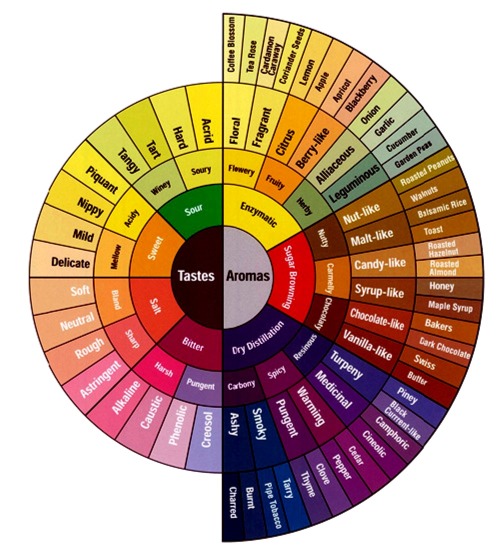
By R. Justin Shepherd, http://spencersbg.tumblr.com
Monday, October 15th, 2012 7:00 AM CST
The picture above is the “Coffee Tasters Flavor Wheel,” an industry-standard illustration of the most common tastes and aromas potentially present in coffee. The left side describes potential “tasteable” flavors — things that your tongue can register — while the right side describes aromas, perceptible by our noses. What’s interesting is that all the really identifiable flavors — blackberry, dark chocolate, clove — show up on the “aroma” side of the wheel.
Two things:
1.) Just by looking at the graphic, it’s obvious that a lot of what we think we “taste” is actually what we smell. (“Flavor” = Tastes + Aromas) This makes sense, since we’ve found that distinct aromas come out more clearly when grinding coffee than in the finished product of brewed coffee. (For example: We have in stock a Sundried Ethiopia Sidamo right now that, when first ground, smells more like a blueberry muffin than coffee. But, once brewed, the blueberry notes are still present in the flavor, though muted and sort of masked by the coffee’s, um, “coffee” flavor.)
2.) When we (or anyone) describe a particular coffee in terms of its “notes” and “undertones,” what we’re doing is not so much pinpointing exact flavors, but rather filtering the coffee through our experience of all the tastes and aromas we’ve saved up in our memories. Thus a baker may be able to better discern and differentiate flavors in the “Sugar Browning” category of the wheel, while a gardener more easily picks out the flavors on the “Enzymatic” end of the spectrum.
There’s a TON to say on flavor, and over the next few days, we’ll look into some of that. But for now, don’t fret if you’ve never tasted balsamic rice or coriander seeds in your coffee — we’re not sure we have, either. Instead, next time you pick up your cup for a sip, slurp it and chew it and swish it and smell it, and see where your mind goes. Because flavor, after all, really begins and ends in your head.










